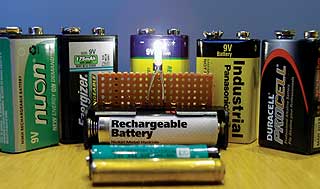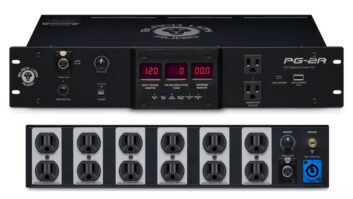
Five 9-volt variations flank a simple AA battery load tester. In front are AAA and AAAA cells, which can be found inside a 9V battery.
Batteries have a language all their own. At the heart of all batteries is a single electro-chemical device called a cell. Examples are the AAA, AA, C and D. In non-rechargeable form, each cell generates 1.5 volts, and when “stacked” (wired in series) multiple cells create a battery; the 9-volt “transistor” and 12-volt “automotive” are the most common. Using simple mathematics, it is obvious that six 1.5-volt cells add up to 9 volts.
Disposable batteries are referred to as a primary power source and are most commonly made from alkaline (zinc-manganese dioxide) and zinc carbon; there are lithium-based disposables, as well. Rechargeable batteries are made from many different materials; nickel cadmium (NiCd), nickel metal hydride (NiMH) and lithium ion are popular with electronic devices; each has properties that make it suitable for certain applications over others.
Relative to primary batteries, the most obvious trade-off with rechargeable batteries is current capacity over time measured in milliAmp-hours (mAh), output voltage (typically less, but improving) and cost. As with many green technologies, the initial investment is higher. Local store prices on single quantities are most discouraging. Bulk buys at specialty stores can cut prices almost in half, yet the cost is easily three times more than, say, a conventional 9-volt battery at $2 a pop in a box of 12.
The Hidden Feature
Modern gizmos are typically rechargeable by design and include power management — an essential feature that’s built in to maximize our pleasure and minimize our pain. Familiar examples include laptops, cell phones and cameras that dim or power-down their screens but are otherwise fully capable, ready to do our bidding at the touch of a button.
The magic behind any energy management system is the software equivalent of having a voltmeter, ammeter, chart recorder and a brain, all in one compact package. Not only is energy transfer optimized during discharge (normal use), but also when charging, to maximize the total number of charge/discharge cycles. In plain English, for dealing with more complex and power-hungry gear, power management squeezes every last drop of juice out of the power source.
Elevated Awareness
Using rechargeable batteries in gear designed for disposable batteries requires a higher consciousness. The initial cost is higher, and it’s also necessary to buy at least two batteries for every device — at minimum, there should always be one charged spare/backup. All should see regular activity.
When the best a vintage stomp box can offer is being “off” when no ¼-inch plugs are inserted, the onus is on us to be “the brain” that handles the power-management chores. How often have you left something on overnight, only to find it dead in the morning? For this reason alone, rechargeable batteries really do pay for themselves several times over in the long run.
Pessimista
Most rechargeable cells produce in the range of 1.2 to 1.45 volts instead of the typical 1.5 volts. This might not seem to be such an issue for one cell, but in applications where multiple cells are in series, the end results may be just above the minimum threshold for operation. Consider these worst-case examples, based on 1.2-volt cells: a camera expecting to see 6 volts from four AA’s instead sees 4.8 volts; walkie-talkies and audio analyzers expecting 4.5 volts from three AA batteries see 3.6 volts.
Dissection of a 9-volt alkaline battery reveals six 1.5-volt cells capable of 565 mAh. The same number of NiCd or NiMH cells — 1.2 volts each — produces only 7.2 volts, so one or two additional cells must be added to make 8.4 or 9.6 volts, respectively. (Lithium-ion cells generate 3.2 volts.)
Primary battery manufacturers are varied, yet we tend to rely on the two popular brands: Energizer (Eveready/Union Carbide) and Duracell. Rechargeables take us into unfamiliar territory, where brand recognition is an oxymoron.

Figure 1: This comparison of AA cell life shows the conventional alkaline (red) battery maintaining power and then suddenly dropping off. The rechargeable NiMH (green) battery shows a gradual voltage reduction over a longer period of time.
Three “discoveries” in the rechargeable 9-volt category help define the expectations. Powerex has a true 9.6-volt/230mAh NiMH battery; Powerizer’s 7.6V/400mAh Lithium Ion version has a built-in PCB to prevent overcharging and over-discharging (notice the trade-off of more capacity, but less voltage), and IPower US has a 520mAh “9-volt” with a working voltage range of 8.4 to 6.5 volts.
Ottimista
With rechargeable batteries, the working voltage may not be too far above the most basic of energy-management systems — the “low battery” warning. The major difference is rechargeable batteries hold the bulk of their charge longer than disposable batteries. Figure 1 details a simple test using a 1.5-volt battery driving a Mini Maglite bulb consuming about 200 mA. The disposable battery is in red; the rechargeable is in green. As you can see, the red dots make an “S” curve, while the green dots go longer and are nearly horizontal, after which the voltage drop-off is severe.
It pays to have a good charger and to know the battery’s history. For example, consider a set of batteries that get exclusive use in a digital camera. Digital cameras are very energy-conscious — they need to accurately write and preserve image data — so these batteries will experience the same charge/discharge routine and as a result, should have a similar life expectancy.
Under the best circumstances there will always be the exception, a “surprise shut-off” that’s most likely caused by only one of the batteries. Testing each battery under load — that is, with a current drain similar to the camera’s requirements — will reveal the culprit. Similarly, inside a disposable 9V are six AAAA batteries — yes, smaller than an AAA! Inside a defective unit, one leaky cell was dead, the other cells ranged from 800 mV to 1.2 volts.
Experience and Observation
I’ve used rechargeable batteries in all sorts of conventional battery-powered gear — from kids’ toys to test equipment, flashlights and student lab kits — and always had plenty of charged spares. After testing several readily available appliances, I learned that an aged digital camera (using four AA batteries) sucked 800 mA when running the motor to extend the lens, then settled in at 500 mA with the screen on. A basic wireless mic, a simple oscillator and an Ibanez Dual Chorus consume 30 mA, 10 mA and 92 mA at 9 volts, respectively.
Modern electronics designed for battery operation consume about one-tenth the current of their cabled cousins. I recently helped a student repair the electronics in an active bass guitar. Inside was a surface-mount TL062 operational amplifier (a dual op amp), the low-powered version of Texas Instruments’ TL080 series, the former consuming 200 µA (micro amps) per amplifier compared to 2 mA (milli-amps)/amp for the latter.
To obtain the most consistent results, I recommend one of the most complex and labor-intensive procedures known to scientists around the world: routine inspection, cleaning and preservation of everything — the battery, device and charger contacts. When using test equipment, it’s amazing how the slightest amount of contamination increases contact resistance, affecting both charge/discharge performance as well as how much pressure must be applied to get stable readings.
The essence of the scientific method is to observe, minimize variables, collect data and correlate the information. This is great when you have time but can be a nuisance when the show must go on and there’s no time for failure. The pressure to have a glitch-free show may put our “green-ness” to the test — it’s common to replace batteries for wireless mics and stomp boxes before every show. Used batteries are often recycled into less critical applications. That said, a little research and experimentation go a long way.
Eddie’s mental battery is long overdue for a recharge in Italy. Send him a postcard viatangible-technology.com.







